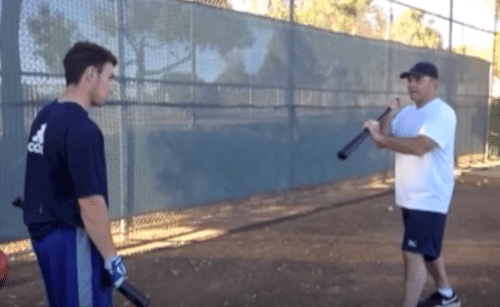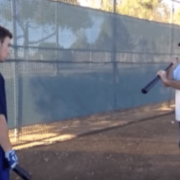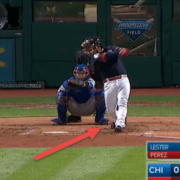Timing Rhythm Hitting Tips To Quickly Improve Early Or Late Swing For Baseball & Softball Batters | Get Front Foot Down On Time In Games
Discover simple timing and rhythm hitting tips from Matt Nokes to quickly improve and fix a too early or late swing for baseball and softball batters. Get the front foot down on time and in games.
Timing Drills For Hitting A Softball Video: Quickly & Easily Get Hitters On-Time w/ “Snap Drill”
I don’t give much of my time to others’ timing drills for hitting a softball. And it’s not because I think I’m God’s green gift to baseball and softball. Actually, since January of 2013, I took a needed break learning hitting mechanics from others in the field, no matter how popular. I wanted to shed the hitting “BEER GOGGLES” that have stubbornly held this industry back for decades.
People ask me if I know anything about Tewks, Epstein, “Teacher Man”, etc. I don’t. And that’s the honest truth. I see their posts on Twitter and Facebook, but don’t give them anymore thought. The main reason? I’m still learning my own system!!

Matt Nokes talking about “leaning in and compressing the ball”. Photo courtesy: Matt Nokes’s YouTube channel
Besides, everyone has a different approach, view, and style. As you probably know, the timing drills for hitting a softball language can get quite confusing.
Back in 2013, I decided to stick to resources on Bio-mechanics, Physics, Psychology, etc. Because THIS is where the answers are. It’s not opinion, or someone’s theory or philosophy based on playing or coaching experience.
My #1 rule is to digest information that is validated by science. Don’t seek the footsteps of others, but seek the resources the “others” sought. In other words, don’t just take my timing drills for hitting a softball word for it.
That being said, there are a couple hitting coaches I do listen to, and one is Matt Nokes. I think he has an unmatched passionate curiosity for hitting, authentically wants to help hitters, is open to new ideas (can’t say that for many online gurus), and gets dramatic results with his hitters in a reasonably short amount of time.
As always, I’ve taken video notes for you, so you can skip around to what interests you most. Some of the things you’ll learn in the video are:
- Swing intention: what Matt Nokes means when he tells his hitters to “lean on it and compress it” (this will upset the ‘bug squisher’ coaches out there),
- Why hitters MUST swing in the same direction as their “swing motor” (and it’s not what you think),
- The “Snap Drill” that will easily and quickly get your hitters on-time (an Ah-ha moment for me!), and
- Much more…
Enjoy!
SCIENCE-BASED TRAINING:
Improve your hitting strategy dramatically by applying human movement principles.
Learn not only how and what to train but also the science behind the methods.
- About 1:00 minute mark, Matt didn’t think about Bat Speed when he was playing, he was trying to “lean on it and compress it”. He calls this “directional force”, in which he says it takes 8,000 pounds per square inch in one direction, to hit a ball 400-feet. CLICK HERE to see our Directional Force drill video.
- About 2:15 minute mark, Matt talks about how hips, knees and feet are the base, core is the motor, and arms are swing levers. What happens when swinging off the plane of the core motor. Swing in same direction as swing motor.
- About 3:30 minute mark, Matt distinguishes between keeping the barrel above hands as a cue versus what really happens. Don’t miss this. He uses this oftentimes blanket-used-coaching-cue to get the hitter flattening his/her barrel to the pitch plane. Barrel MUST match shoulder plane.
- About 5:30 minute mark, Matt defines a timing drills for hitting a softball approach as summing up what you’re trying to do mechanically into a one or two word cue. Ever changing because getting new info, new feelings, new observations. Talks about 2-3 minute “priming” movements before heading into battle.
- About 10:15 minute mark, great hitters don’t “keep their hands inside the ball” in a way that creates what Matt calls slack. He refers to the Fence Swing Drill that exaggerate swinging down.
- About 12:00 minute mark, Matt talks about transferring force with a bent landing knee, comparing to a Pole Vaulter’s pole when it sticks into the ground before propelling the athlete up. Landing bent allows for adjustment. “The front knee isn’t straightened, it gets straightened. The back leg doesn’t turn, it gets turned. The core moves the legs.”
- About 14:45 minute mark, Matt breaks down how to “flatten” the swing. Tells hitter minimal movement from lower half swings, just focus on moving shoulders, hands, and bat. Matt gives limited parameters, and let’s hitter learn the lesson…in other words, he doesn’t map out step by step how to move the way he wants the hitter to move. Gives hitter an outcome and allows them to fill in the blanks.
- About 16:30 minute mark, Matt talks about swing approach like what you’d do to chop down a tree. You wouldn’t think about how did I swing the ax yesterday. You’d just start swinging it! Finishing low with the hands and following the line of impact. I call this driving the big nail (Matt’s bat in the video) flush into the wall. At about 20:00 minute mark, Matt adds to this and tells hitter to “lean on this” and “compress it” (referring to his bat). He says that he just gave hitter permission to hit the crap out of the ball.
- About 18:30 minute mark, compares big picture timing drills for hitting a softball cues to Fence Swing Drills. The latter being ineffective as a default way to hit. You have to hit with big picture in mind of what you want to do to the ball. Swing intention.
- About 21:00 minute mark, Matt begins to talk about timing. Timing is a distance, and to make it simple by synchronizing timing from release to contact. Matt talked about how he took a guy hitting the ball 360-380 feet to hitting it 480-feet in 2.5 months…over the fence, 400-feet off a tee. “Feel” contact…stay sideways and feel contact by leaning and compressing the ball. Matt talks about the “Snap Drill”. This is golden! He also talks about the “Ride” part of “Ride & Stride” that Matt promotes within his system.
If you remember one timing drills for hitting a softball thing from this video, it’s from the 21st minute on… 🙂 Golden.
Unlike most MLB players and coaches, Matt Nokes has an intuitive sense of the swing. He can explain it from a “real” point of view, and transition that into “feel”. His system seems to fill in the blanks that I’ve always had about the swing. The good news about his principles is they’re very simple and easy to implement. Matt has a very common sense approach to hitting.
- CLICK HERE to visit his Hitting Solutions website to get more information,
- Subscribe to him on YouTube, and
- Follow him on Twitter…
Thanks Matt!
- Fix Late Swings Fast: 2025 Pitch Recognition & See-Decide-Swing Training for Youth Baseball Power Hitters - October 6, 2025
- Safe Youth Weighted Bat Training: Proven Overload/Underload Drills to Increase Exit Velocity in Games Starting Tonight - September 29, 2025
- AI Coaching Course 2025: Youth Baseball & Softball Practice Plan + Off-Season & In-Season Workout Builder Fast - September 23, 2025













I love his passion to teach… I feel like Matt was more excited than the hitter….I like how he teaches… I usually say ” Go to the ball” which I think but I’m not sure Matt expresses with lean…Joey can you discuss leaning for me please… The more I think about it the more I like that cue…
He teaches a lot of great things….I think I don’t understand his stop and quitting notion… As per my understanding, there has to be a stop to transfer but it’s not like a literal stop since our man I got parts have many slings… So for me, you have to stop some slings to transfer….Can you discuss his stop and quite notion he didn’t like…
I like how he presets his arms… you know I’m all about pre-setting….I really like how he thinks of the shoulder ceiling and not really the bat path….That is big time… Obviously compression is a great term… Many great things….
~DM
Djura, from my understanding, the main point Matt is trying to get across is getting the hitter to time up full linear momentum into impact. Stopping it takes away from overall distance. Directional force is key and you can’t get that without the “core motor” and linear momentum into the ball…if that stops, then the hitter is all arms, and this is the stop and quit he is referring to. That’s my understanding anyway. His knowledge is definitely a lighthouse in a thick fog 😉
Great stuff. Any idea what type of bat he is using. Love the idea of a lighter bat for BP work. Thanks Joey!
Bob, he calls them Ninja Bats and for the life of me I can’t find them on Amazon or on his page. I’ll have to ask.
At the 21 minute mark he tells the kid not to move backwards. Does this mean when “showing numbers” you are back far enough? I wasn’t sure what he meant.
Also, what does he mean technique wise when he says compress the ball and swing hard? Is that allowing for the back foot to skip forward for more Force?
Jonathon, great question. He did this video back in 2013, so he had zero knowledge of my system (we officially met in 2015 I believe). Now I don’t agree with cutting out the back motion because that is essential to all human movement, while changing directions. To be clear, you can ‘show numbers’ before the swing even starts. You don’t have to move into that movement, you can start in it.
The power in using “compress the ball” cue is it’s an external one. Lumberjacks in competitions don’t think about the mechanics of an “ax swing”, they’re thinking about burying the blade into the wood. In my opinion, compress the ball is to lean the hitters weight into impact and compress the ball with the bat like a pancake, or like I say drill the head of the nail (ball) flush into the wall. Matt is talking about directional force here, this is so important. 8000-lbs of force per square inch in one direction, is what it takes to hit a ball 400-feet. The keyword there is “in one direction”.
Joey… compress the ball is a que I like but still have a hard time getting some people to grasp…. For me, there are many things that are going on which makes “compress the ball” FEEL right… You say it’s an external que but for me it’s an external to internal que…
So what does than mean? For me, there is a pointing of the lead arm and a pressing in the rear arm or elbow that goes through… And a first feeling that should feel like you are pushing your hands together and at a moment later a 2nd feeling by taking all that energy and pushing your energy in opposite positions on top off each other…And while this is happening, the batter ought to feel the body, particularly the trunk, get tighter and tighter… And this energy is taken right to the ball….
One thing I like is finger tips to the trunk… or to the hips…than the hips or trunk back to the finger tips…
So compression is seen from the external and you match that with a feeling that is internal and transferred to the ball… So when I say “go to the ball” I added at some point and take your energy to the ball and compress it…. I’ve tried… hold your breath before you go to the ball… but now I’m opening a can here as this gets complicated… But what I like is the feeling that the batter is transferring his energy to the ball… if I think of transferring my energy to the ball it’s easy for me to get directional….
So if you think about what I said… you can expand it to … energy goes from the barrel to the hips and back from the hips to the barrel and transferred to the ball…
I love the “lean” term but trying to figure out the best way to include it with my “go to the ball”, “take your energy to the ball and compress it”, make sure to hit across your face…is difficult…
Also, being a Yankees fan I remember Nokes well… he approaches the ball well… But his coil was not completely tighten meaning his alignment could not have been in the most powerful position which was obvious because if he had that tight of a coil with his approach to the ball he would have been unstoppable in my view….
Good stuff… I still don’t like the stop and quit because to me and I may that understand it correctly is, if a batter stops and quit… They don’t understand the kinetic chain…Meaning they are cutting out a part of the chain so saying stop and quit shoukd just be replaced with the missing part…
I feel like it’s similar to ” stay inside” which basically means swing the right way… you have to stay inside the ball translates to…you have to swing correctly… which makes sense to me because when I ask how do we stay inside I get some really classic answers…
“Full linear momentum”… can you explain that to me a little bit more….Are you talking about the multiple transferring of energy???
Joey, Some of this seems contrary to your system. Could you point some things you differ on?
Hey Jim, what are you seeing that’s contradictory?
Ok… I think the reason I don’t like the phrase stop and quit is it’s talking about 3-dimension move but putting it in terms of 1-dimension….
And this now even goes into the other comment I had in another article… regarding breathing and holding your breath… At some point you have to firm up and it LEADS to a holding of ones breath to a certain extent but it’s not like it exactly…So firming up is like bracing but yet again it depends on how we want to define these things as some of these things are preset in order to get the tightest coil possible which gives the batter full connection and more importantly let’s our nerves get engaged in the right way which leads to the right movements without resistance…And at the end it all ties together with your pelvic floor… I believe I once told you that if you hold your pee you may get what I’m saying….
Also I once said if your riding a bike after you peddle your legs still goes with your motion and you start using your quads or whatever muscle it is…
So do we stop… Well the chain goes from A to B to C… etc… but that doesn’t mean that only one chain is engaged… There are other chains balancing and others moving other things even in the same body parts…
And this is why I don’t like the linear to rotational to linear phrase.. it’s telling one chapter in a book with many chapters…
Please comment Joey as I’m not entirely sure myself…
~DM
Why is his upper half coming over his front leg – a linear Charley Lau/Walt Hriniak approach?
Also, notice the angle of his back leg. Shouldn’t it be at a 90 degree angle. He appears to lunging.
The difference between Brandon’s initial swings and those at the end are noticeable. At the beginning of the video, Brandon was striding into the plate (more than the Xenolink recommended 10 degrees), looking out over the plate, barring his front arm to compensate, and hitting around the ball a bit.
At the end of the tape, Brandon was striding straight ahead, his head position was more forward looking, and he wasn’t barring his front arm. But Matt didn’t address any of those issues. Brandon’s upper half did not come over his front leg, though Matt’s upper half came over his own front leg in every one of his demonstrations.
Joe , his head being front going is a big time observation…. I really like that…
His barring his arm shouldn’t be an issue if he knows how to do it correctly… said another way, barring of the front arm is built in the swing…. Said, another way, I think barring is a must in the high level swing…The issue is when it’s not built in the right way…
Let me say it differently, the grip is not just slapped on the handle… It’s placed on the handle in a very specific way for a reason… Same with the forearms and the upper arms…Meaning our upper limbs are held with forces built in… Built in to our trunk and also just built in with our hands…Everyone is looking to make it LOOK the part but it should FEEL the part….And that FEEL is what gives our grip and our arms something BUILT IN….
Notice when Nokes extents his arms down and works his wrist to lock that extension and than used his hands to bring his “hands” up…
So if locked his arm barred and just brought the handle up he …………………..
Happy thanksgiving Joe…. and like always I’m probably wrong who knows ?…
Joey… feel free to comment ?
~DM
Seriously nobody has any comments on what I said or wants to add to the discussion… I’m not entirely sure if I agree with what I said or understand it correctly … Perhaps either I’m so off that everyone doesn’t want to bother or I’m coming from MARS and everyone doesn’t even joe where I’m coming from… All I know is APPROACH is the most important thing for me… And I feel like Nokes is speaking in those terms not some external ques… I feel approach needs to come from the position of getting set up in the best alignment than using your hands to get in the right position than doing all the external crap most others are teaching…So if you don’t know how to set up you will fail… if you know how to set up you still need to know how to get to the right position or else you will fail…
So the parts we see in slow motion would be the 3 part after setting up and positioning… some slow motion videos do get the 2 part in the video too but most almost always fails to get the first part in… The little weird things people usually miss…Those weird things are setting up like setting up to bench or squat… It ALL starts from there…
By the way, anybody reading this… Am I losing everyone… or am I lost….
Any comments would be appreciated…
Happy Holidays…
~DM